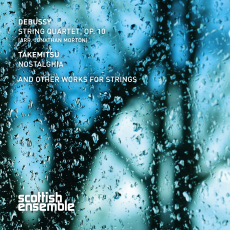Scottish Ensemble - Debussy & Takemitsu - MusicWeb International
To my mind, this is an arresting and, in the main, successful arrangement of the Debussy String Quartet. We hear it as reconfigured for seventeen string players by the Scottish Ensemble’s Artistic Director and Leader, Jonathan Morton. Evidently he has been keen to employ additional double basses amongst his players to support and emphasise Debussy’s cello line where appropriate.
Debussy marked his opening movement Animé et très décidé and Morton ensures that his arrangement is just that: plenty of attack, the music airy, breezy and but with that special aura of nostalgic yearning too. The second pizzicato movement, Assez vif et bien rythmé, is sharply etched and trenchant but not without humorous touches suggesting a rather feline approach, claws out. The exquisite Andantino, doucement expressif is sensitively expanded for additional strings maintaining but emphasising its quiet introspection, its feeling of yearning and pleading and, at its heart, possibly, prayer-like supplication ascending to an ecstatic climax. The finale, Très modéré, begins slowly and morosely but soon accelerates until it reaches what Debussy had marked, Très mouvementé et avec passion. Morton propels the music forward with passion aplenty. I rather think Debussy would have smiled on this arrangement of his String Quartet.
As far as The Girl With the Flaxen Hair is concerned I am not so sure. I could not help wondering if arranger Colin Matthews had seen and been influenced by the 1948 David O Selznick-produced fantasy film, Portrait of Jenny. For the score Dimitri Tiomkin adapted music by Debussy including this engaging little piece. Here there is a very similar atmosphere of misty whimsy. It conveys an ethereal other-worldliness with subtle harp additions whereas Debussy’s girl was a more substantial human figure. Jimbo’s Lullaby comes from Debussy’s Children’s Corner Suite and as Philip Borg-Wheeler observes in his notes, ‘these are childhood scenes as viewed by an adult observer’ and far too sophisticated for children to play and appreciate. Jimbo was Debussy’s daughter’s toy elephant. Here James Manson’s expanded view explores all the lumbering gait and endearing characteristics of the beloved toy and did I catch a glimpse of some chinoiserie?
Takemitsu’s music provides an appropriate teaming. His Funeral Music from the film Black Rain is dark and disturbing, even menacing and I was very much reminded of Bernard Herrmann’s equally hair-raising music for Hitchcock’s Psycho. On the other hand his jazz-influenced Music for Training and Rest, a reworking of a score for the documentary film about a boxer, José Torres has a most beguilingly lovely romantic melody speaking of exquisite yearning as well a striking pizzicato riff over expansive violin phrases. Takemitsu’s Nostalghia was written ‘In Memory of Andrei Tarkovsky’, regarded as one of the greatest film directors. ‘Nostalghia’ means more than nostalgia; it is a very real feeling of homesickness. This music is unconnected with a film; rather it is an elegy for Tarkovsky’s art in general. The dejected melancholy in the music is pitiful but there are sweeter tones too. A persistent heavy ostinato, figures below with a sour edge, suggesting, perhaps, some political disturbances?

